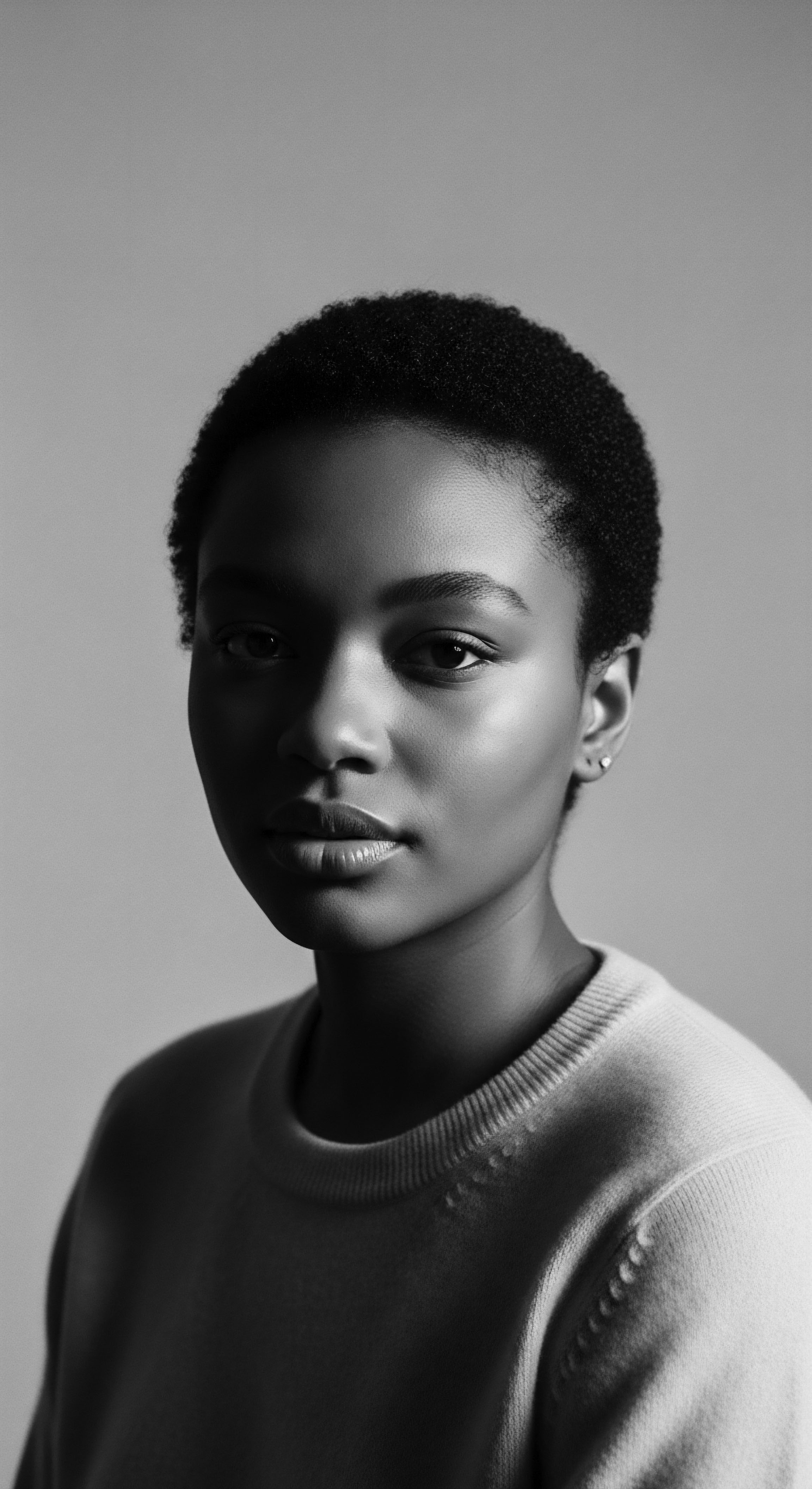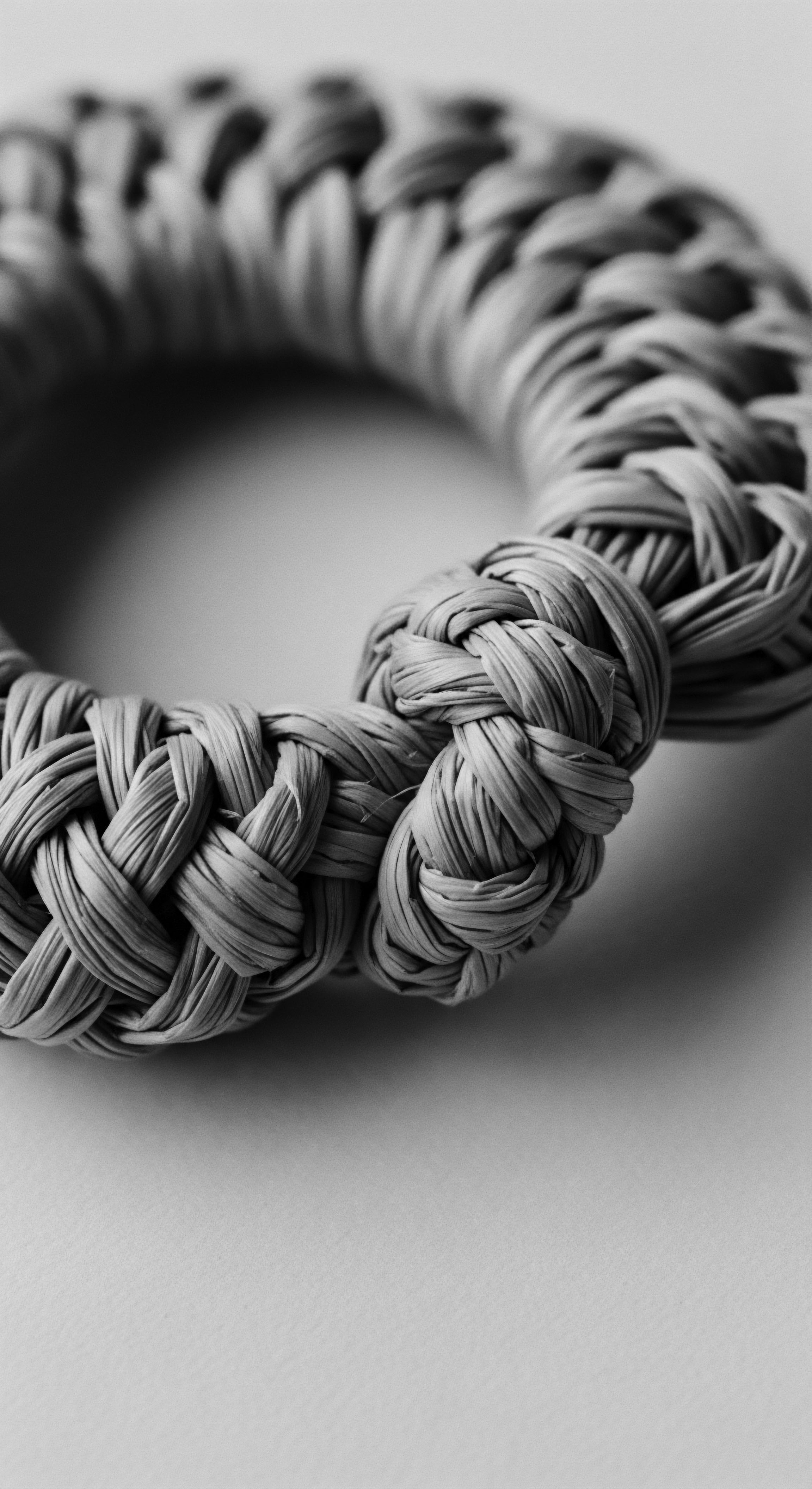
Fundamentals
The Sodium Hydroxide Relaxer, often called a “lye relaxer,” stands as a powerful chemical preparation specifically designed to straighten tightly curled or coiled hair textures. This hair alteration treatment functions by disrupting the natural disulfide bonds within the hair shaft, resulting in a permanent change to the hair’s curl pattern. Its fundamental aim is to render hair smoother and more manageable. The application of this compound represents a significant chapter in the journey of hair care, particularly for individuals with textured hair who have long sought varied styling possibilities.
From its earliest commercial iterations, the Sodium Hydroxide Relaxer brought forth a transformative capability, allowing for a degree of straightness previously achievable only through laborious, temporary heat methods. The basic explanation of this process rests upon an understanding of hair’s foundational architecture. Hair strands, though appearing simple, comprise complex protein structures, primarily keratin. These proteins are linked by various chemical bonds, among which disulfide bonds play a crucial role in determining the hair’s inherent curl, its very contour.
Sodium hydroxide, being a strong alkali, facilitates a chemical reaction known as lanthionization, irreversibly breaking these disulfide bonds. Once broken, the hair can be physically manipulated and reshaped into a straighter configuration.
The initial engagement with such a potent substance carries a history deeply entwined with the desire for diverse hair expressions. Understanding this elemental process helps us appreciate the historical meaning and practical delineation of the Sodium Hydroxide Relaxer in the wider context of hair care. The impact extends beyond mere aesthetics, reaching into aspects of daily life and social interactions.

Chemical Action at the Hair’s Core
At its simplest, the Sodium Hydroxide Relaxer operates by initiating a profound chemical transformation. The relaxer cream, typically containing sodium hydroxide as its primary active ingredient, is carefully applied to the hair. The high alkalinity of this compound causes the hair cuticle, the outermost protective layer, to swell and open. This allows the active agents to penetrate the cortex, the central part of the hair shaft where the protein bonds reside.
Within the cortex, the hydroxide ions react with the disulfide bonds, which are strong linkages between sulfur atoms in the keratin proteins. These bonds are responsible for the hair’s natural strength and curl memory. The chemical reaction cleaves these bonds, converting them into lanthionine bonds, which are single sulfur bonds that do not readily reform into the original curl pattern.
This irreversible change is what gives the relaxer its permanent straightening ability. The hair, now softened and structurally altered, can be smoothed out and set into a straighter form before a neutralizer is applied to halt the chemical process and re-harden the hair in its new shape.
The Sodium Hydroxide Relaxer works by fundamentally altering the hair’s internal structure, transforming tight curls into a smoother texture through a powerful chemical reaction.

Early Echoes of Hair Alteration
Long before the advent of modern chemical relaxers, human societies experimented with various methods to alter hair texture. Ancient civilizations, such as the Egyptians, used alkaline substances to loosen curls, indicating a historical precedent for chemically-assisted hair modification. These ancient practices suggest a long-standing human desire for variety in self-presentation, with hair serving as a canvas for expression.
The echoes of these early explorations resonate through centuries, laying a foundational understanding for later chemical interventions. The notion of using natural elements to achieve different hair finishes persisted in various cultures globally, evolving alongside available knowledge and resources. The history of hair manipulation, therefore, is not a recent phenomenon but a continuous thread woven into the fabric of human adornment and identity.

Intermediate
Moving beyond the foundational insights, a deeper understanding of the Sodium Hydroxide Relaxer involves exploring its specific chemical composition, its historical context within Black and mixed-race communities, and the distinctions between its various formulations. The meaning of this treatment extends into a broader cultural conversation about identity, adaptation, and beauty standards, especially through the lens of textured hair heritage.
The Sodium Hydroxide Relaxer, sometimes colloquially referred to as “lye relaxer,” received its widespread recognition due to its powerful efficacy in smoothing highly textured hair. The term “lye” itself refers to sodium hydroxide, a caustic alkaline chemical. This particular formulation stands apart from “no-lye” relaxers, which employ different alkaline agents like calcium hydroxide or guanidine hydroxide. While both types aim to straighten hair, the sodium hydroxide variant operates with a distinct chemical pathway and intensity, offering a permanent alteration that demands careful application and management.

The Lye Distinction and Its Impact
The primary distinguishing characteristic of a Sodium Hydroxide Relaxer is the inclusion of sodium hydroxide (NaOH) as its active straightening agent. This compound, also known as lye, possesses a very high pH, typically exceeding 12, and often reaching 13 or more in earlier formulations. This extreme alkalinity is potent enough to break down the hair’s complex protein structure quickly and effectively. When the relaxer is applied, the hydroxide ions from the sodium hydroxide penetrate the hair shaft.
They break the strong disulfide bonds that maintain the hair’s natural curl pattern through a process called lanthionization, changing the cysteine amino acid into lanthionine. This alteration is irreversible, meaning the hair that has undergone this process will remain straight until new growth emerges from the scalp.
The immediate and profound chemical change delivered by lye relaxers made them particularly effective for very tightly coiled hair, offering a sleekness that was difficult to attain otherwise. However, this potency also brought heightened risks, particularly concerning scalp burns and hair damage if not applied with utmost precision and care. The powerful nature of these early chemical compositions shaped not only hair texture but also the rituals and cautions surrounding their use in homes and salons across communities.

Historical Footprints in Textured Hair Heritage
The historical roots of chemical hair straightening reach back to the early 20th century, with a significant moment arriving with the invention of Garrett Augustus Morgan’s “G.A. Morgan Hair Refiner” in 1913. Morgan, an African American inventor known for his contributions to public safety, stumbled upon the hair-straightening properties of a chemical solution while working on a lubricant for sewing machine needles.
His ingenuity led to a product that offered Black individuals a new means of altering their hair texture. This invention, while born from scientific curiosity, entered a world where Eurocentric beauty standards often dictated perceptions of professionalism and acceptance.
The advent of chemical relaxers significantly altered hair care practices, particularly for Black women seeking integration into societal norms shaped by Eurocentric beauty ideals.
The widespread adoption of chemical relaxers, especially by African American women, was deeply influenced by societal pressures. In post-slavery America and during the Jim Crow era, straightened hair often became a practical tool for navigating systems designed to devalue Black identity. It represented a means of achieving a “respectable” appearance that could potentially open doors to employment and social mobility that were otherwise closed due to racial discrimination against natural hair. This historical context is vital when considering the definition of the Sodium Hydroxide Relaxer, as its meaning is inextricably linked to the struggle for acceptance and self-presentation within a restrictive societal framework.
Over time, the market expanded, with companies like Proline commercially producing lye relaxers in 1971. The late 1970s and early 1980s saw the introduction of “no-lye” relaxers, utilizing gentler alkaline agents to reduce the harshness and potential for scalp burns associated with sodium hydroxide formulations. This evolution speaks to a continuous seeking of safer, yet effective, hair alteration methods, driven by consumer needs and a growing awareness of the product’s physical impacts.
The significance of these shifts for Black women’s experiences cannot be overstated. The choice of relaxer, or whether to relax at all, became a very personal and often political statement. It reflects a legacy of adapting, challenging, and redefining beauty within the unique tapestry of Black and mixed-race hair heritage. The discussion moves beyond simple chemical definition, reaching into profound historical and social dimensions.

Evolution of Straightening Agents
The journey from rudimentary hair-smoothing techniques to the sophisticated chemical relaxers of today illustrates a persistent human inclination to reshape personal appearance. This pathway has been marked by both ingenious discovery and a deep reckoning with societal expectations.
- Ancient Alkalines ❉ Early attempts to relax hair involved natural alkaline substances, perhaps plant ash or certain mineral compounds, signaling a foundational understanding of chemical alteration dating back centuries.
- Hot Combs ❉ In the 19th century, heated metal combs became prevalent, especially among Black women, offering a temporary smoothing effect, a precursor to more lasting chemical solutions. Madam C.J. Walker played a significant role in popularizing and improving these tools, alongside developing hair care preparations.
- Garrett Morgan’s Breakthrough ❉ The early 20th century saw the true genesis of the chemical relaxer, with Morgan’s formula using lye, which provided a more lasting straightening.
- The Rise of Commercial Lye Relaxers ❉ By the mid-20th century, companies like Johnson Products (with Ultra Sheen) commercialized sodium hydroxide relaxers, making them widely accessible and culturally significant in Black communities.
- No-Lye Alternatives ❉ The introduction of calcium hydroxide and guanidine hydroxide-based relaxers aimed to provide a milder alternative, addressing concerns about scalp irritation and potential damage from lye formulations.

Academic
The Sodium Hydroxide Relaxer, in its rigorous academic delineation, represents a potent alkaline chemical system engineered for the permanent alteration of the hair’s natural helical structure, transforming highly coiled or kinky textures into a straightened configuration. This chemical intervention relies on the profound reactivity of sodium hydroxide (NaOH) with the intricate protein matrix of the hair shaft, a process culminating in irreversible disulfide bond scission and the subsequent formation of lanthionine bridges. Understanding this complex chemical reordering, its physiological implications, and its deeply stratified psychosocial dimensions provides a comprehensive meaning that extends far beyond mere cosmetic application, reaching into the historical, cultural, and identity landscapes of Black and mixed-race hair.
The mechanism of action for sodium hydroxide relaxers is fundamentally rooted in their exceptionally high pH, typically ranging from 12 to 14. This extreme alkalinity causes the outer cuticle layers of the hair to lift and swell dramatically, facilitating the rapid ingress of hydroxide ions into the hair’s cortical region. Once within the cortex, these hydroxide ions catalyze the hydrolysis of disulfide bonds (S-S), which are critical covalent linkages between cysteine residues that stabilize the hair’s natural conformation. The reaction, known as β-elimination, results in the breaking of these bonds and the formation of new, more stable monosulfide lanthionine bonds (C-S-C).
This chemical re-linking permanently reconfigures the hair’s internal architecture, allowing the hair to be mechanically straightened and set into a new, elongated form. The irreversible nature of lanthionine bond formation means that the treated hair remains straight, requiring subsequent applications only on new hair growth at the roots.
The academic comprehension of the Sodium Hydroxide Relaxer necessitates an exploration of its impact beyond the molecular level, recognizing its position within a historical continuum of hair manipulation and its profound influence on identity formation. For Black women, specifically, the choice to use relaxers has often been less a simple styling preference and more a complex response to prevailing societal norms and pressures.

Chemical Reordering and Biomechanical Impact
The precise chemical definition of a Sodium Hydroxide Relaxer as a lanthionizing agent is central to appreciating its effects. The chemical reaction is highly exothermic, meaning it generates heat, which can exacerbate scalp irritation if not managed with precision. The efficacy of the relaxer is directly proportional to its concentration and the duration of its application.
However, the inherent strength of sodium hydroxide also carries significant risks. The aggressive breaking of disulfide bonds can lead to a considerable reduction in hair tensile strength, rendering the hair more susceptible to breakage, dryness, and a compromised cuticle integrity.
Scalp health is another critical dimension. The high pH of sodium hydroxide formulations can cause chemical burns, irritation, and inflammation of the scalp, particularly if pre-existing abrasions or sensitivities are present. Repeated exposure or improper application can lead to chronic scalp conditions, including scarring alopecia (hair loss due to follicle destruction) such as central centrifugal cicatricial alopecia (CCCA), which disproportionately affects Black women. These physiological consequences underscore the need for meticulous application by trained professionals and a thorough understanding of the product’s chemical properties.
Sodium hydroxide relaxers permanently alter hair structure through lanthionization, a process with significant biomechanical consequences for hair integrity and scalp health.
The delineation of the Sodium Hydroxide Relaxer must therefore encompass not only its chemical reactivity but also the subsequent biomechanical alterations to the hair fiber. The hair shaft, post-relaxation, exhibits reduced elasticity and strength. This diminished structural integrity requires specialized post-treatment care aimed at re-moisturizing and reinforcing the hair’s outer layers. The concept of “deep conditioning” after relaxation is thus not merely a recommendation, but a critical component of hair health maintenance, addressing the profound changes initiated by the alkaline agent.

Sociological and Psychological Dimensions of Textured Hair Alteration
Beyond its scientific description, the Sodium Hydroxide Relaxer carries a heavy sociological and psychological weight, particularly within Black and mixed-race communities. Historically, the pursuit of straightened hair has been intertwined with attempts to conform to Eurocentric beauty standards, which privileged straight, fine hair textures over the coily, kinky, and voluminous natural textures characteristic of African descendants. This beauty hierarchy was deeply entrenched during slavery and perpetuated through discriminatory practices in post-emancipation society, where straightened hair was often a prerequisite for employment or social acceptance.
The decision to relax hair, therefore, has seldom been a purely aesthetic one. It has often been a coping mechanism, a form of adaptation to systemic racism and hair discrimination. A compelling statistic from the Black Women’s Health Study, as reported by Coogan et al.
(2020), illuminates this widespread practice ❉ an astounding 89% of Participants Reported Having Used Chemical Relaxers or Straightening Products in Their Lifetime, with 96% of those first using them at or before the age of 19. This figure speaks volumes about the pervasive role of relaxers in the lived experiences of Black women, suggesting a cultural script where hair alteration becomes a rite of passage, often initiated in childhood.
The psychological burden associated with this pressure is significant. Research indicates that Black women frequently feel compelled to chemically straighten their hair to circumvent discrimination in academic and professional spaces. The concept of “good hair” (straight or loosely curled) versus “bad hair” (tightly coiled, natural textures) became deeply ingrained, leading to internalized racism and negative self-perception for some. Personal narratives frequently reveal experiences of discomfort, scalp burns, and the societal expectation that Black hair must be “managed” or “tamed”.
Despite these complexities, the practice of relaxing hair has also been a site of communal bonding, knowledge exchange, and personal ritual within Black families and salons. The hair salon, in particular, often served as a vital social hub, a space for shared experiences, conversation, and collective care, where the application of relaxers was one aspect of a wider beauty regimen and cultural exchange. This duality — the external pressure to conform versus the internal creation of community and ritual — represents a central tension in the historical meaning of the Sodium Hydroxide Relaxer.
The decision to relax hair has been profoundly shaped by historical discrimination, often serving as a tool for assimilation and acceptance within Eurocentric beauty standards.

Health Considerations and Evolving Understandings
The academic analysis of Sodium Hydroxide Relaxers also encompasses a detailed examination of their long-term health implications. Beyond immediate scalp irritation and hair damage, growing research has pointed towards more systemic health concerns. Studies, including those from the Black Women’s Health Study, have investigated potential links between chemical relaxer use and reproductive health issues, such as uterine fibroids and, more recently, uterine cancer. These studies are particularly significant given the disproportionately high rates of relaxer use among Black women and the higher incidence of certain aggressive cancer subtypes within this demographic.
This contemporary understanding underscores the ongoing evolution of hair care knowledge. As scientific inquiry deepens, so does the awareness of the full scope of effects stemming from historical beauty practices. The ongoing litigation surrounding hair relaxers and their potential health risks further amplifies the need for thorough, evidence-based discourse, especially for products predominantly marketed to specific communities.
The shift towards the natural hair movement in the late 20th and early 21st centuries represents a powerful reclamation of Black hair heritage. This movement, fueled by a desire for self-acceptance, health, and a rejection of Eurocentric beauty norms, has broadened the conversation about textured hair, encouraging a deeper appreciation for its inherent beauty and versatility. The academic lens, therefore, also examines this counter-narrative, recognizing how it challenges the historically dominant meanings ascribed to straightened hair and redefines beauty on terms more aligned with ancestral wisdom and self-determination.

Comparative Analysis of Hair Alteration Methods
The historical and ongoing quest for straightened hair has spurred a variety of methods, each with distinct chemical foundations and impacts on hair structure and health. A comparative look offers a richer understanding of where the Sodium Hydroxide Relaxer positions itself within this spectrum.
| Technique Traditional Heat Methods (e.g. Hot Comb) |
| Primary Mechanism Temporary disruption of hydrogen bonds through heat. |
| Historical/Cultural Context Widely used in 19th-20th century Black communities as a temporary styling solution for smoother hair; a household ritual. |
| Benefits (Historical/Perceived) Temporary straightness, no permanent chemical alteration; accessible. |
| Considerations (Historical/Modern) Requires frequent reapplication; risks of heat damage, burns to scalp. |
| Technique Sodium Hydroxide Relaxer ("Lye") |
| Primary Mechanism Permanent breaking of disulfide bonds via lanthionization at high pH (12-14). |
| Historical/Cultural Context Pioneered by Garrett Morgan (1913); became widespread due to efficacy in permanent straightening and societal pressures for conformity. |
| Benefits (Historical/Perceived) Long-lasting straightness, high efficacy for tight curls; perceived ease of daily styling. |
| Considerations (Historical/Modern) High risk of chemical burns, hair breakage, dryness; potential links to systemic health issues. |
| Technique "No-Lye" Relaxers (e.g. Guanidine Hydroxide) |
| Primary Mechanism Breaking of disulfide bonds through different alkaline agents, often calcium hydroxide, at slightly lower pH. |
| Historical/Cultural Context Introduced in late 1970s/early 1980s as a "milder" alternative to lye relaxers, marketed for at-home use. |
| Benefits (Historical/Perceived) Reduced immediate scalp irritation compared to lye; still provides permanent straightening. |
| Considerations (Historical/Modern) Can cause calcium buildup (mineral deposits) on hair, leading to dryness; still carries risks of damage and breakage. |
| Technique Keratin Treatments / Brazilian Blowouts |
| Primary Mechanism Coating hair with keratin and sealing with heat, temporarily smoothing cuticle and reducing frizz. |
| Historical/Cultural Context More recent (late 20th/early 21st century) global trend; focus on frizz reduction and smoothing rather than extreme straightness. |
| Benefits (Historical/Perceived) Temporary frizz reduction, increased shine, lasts several months; gentler than relaxers. |
| Considerations (Historical/Modern) Often contain formaldehyde-releasing agents, which pose inhalation risks; not a permanent straightener. |
| Technique Each method carries its own historical legacy and physical impact, reflecting a continuous interplay between scientific advancement, cultural demands, and the evolving understanding of hair health across diverse heritages. |
The intricate balance between desired aesthetic outcomes and hair integrity remains a central challenge in hair care science, particularly for textured hair. The ongoing reevaluation of chemical relaxers, driven by both scientific scrutiny and a renewed appreciation for ancestral hair forms, continues to redefine what it means to care for and adorn Black and mixed-race hair.
This nuanced understanding helps to appreciate the multifaceted nature of the Sodium Hydroxide Relaxer’s meaning, linking its chemical underpinnings to its deep cultural roots and its enduring presence in the personal and collective narratives of textured hair. The exploration of its past and present clarifies its complex identity within the rich tapestry of human hair heritage.

Reflection on the Heritage of Sodium Hydroxide Relaxer
The journey of the Sodium Hydroxide Relaxer, from an accidental discovery to a pervasive beauty staple, then to a subject of profound cultural and health reassessment, mirrors the complex narrative of textured hair itself. It stands as a testament to the enduring human desire for self-expression and adaptation, deeply intertwined with the societal currents that shaped the experiences of Black and mixed-race communities. For generations, the relaxer offered a pathway, sometimes a perceived necessity, for navigating a world often unreceptive to the natural contours of Afro-textured hair. It was a tool that, while promising ease and conformity, often came with a silent cost, a physical and psychological burden carried across generations.
Yet, the narrative of the Sodium Hydroxide Relaxer cannot be distilled into a singular story of oppression or liberation. It is, instead, a rich, layered account of resilience, innovation, and self-determination. The salons that hummed with the scent of relaxers were not merely places of chemical transformation; they were sacred spaces of community, storytelling, and shared sisterhood, where care rituals were passed down and identities affirmed, even amidst the backdrop of societal pressures. This deep connection to community, to shared experiences, and to the living traditions of care forms an indelible part of the relaxer’s heritage, a thread woven into the very fabric of Black hair history.
Today, as the natural hair movement gains immense strength and cultural prominence, there is a collective turning towards ancestral wisdom, a celebration of the unbound helix in all its glorious forms. This shift does not erase the historical significance of the relaxer; rather, it allows for a more compassionate and comprehensive understanding of its place in the timeline of textured hair care. It invites a re-examination, not with judgment, but with empathy and a profound respect for the choices made across generations, often under challenging circumstances. The legacy of the Sodium Hydroxide Relaxer stands as a powerful reminder of how hair, in its very essence, serves as a living archive of identity, culture, and unwavering spirit.
The dialogue surrounding relaxers today extends beyond the chemical reaction, reaching into health equity, ancestral knowledge, and the continuing work of redefining beauty standards. It encourages us to look inward, to listen to the whispers of our hair, and to honor the diverse paths our strands have traveled. The story of the Sodium Hydroxide Relaxer ultimately contributes to a richer, more nuanced understanding of textured hair heritage, inspiring a future where every curl, coil, and wave is celebrated for its inherent beauty and ancestral lineage.

References
- Coogan, P. F. Rosenberg, L. & Bertrand, K. A. (2020). Chemical/Straightening and Other Hair Product Usage during Childhood, Adolescence, and Adulthood among African-American Women ❉ Potential Implications for Health. Environmental Health, 19(1), 10.
- Banks, I. (2000). Hair Matters ❉ Beauty, Power, and the Politics of African American Women’s Hair. New York University Press.
- Byrd, A. & Tharps, L. (2001). Hair Story ❉ Untangling the Roots of Black Hair in America. St. Martin’s Press.
- Coogan, P. F. Bertrand, K. A. Palmer, J. R. & Rosenberg, L. (2020). Hair relaxer use and risk of uterine leiomyomata in African American women. American Journal of Epidemiology, 189(12), 1541-1550.
- Collins, P. H. (2004). Black Sexual Politics ❉ African Americans, Gender, and the New Racism. Routledge.
- Jacobs-Huey, L. (2206). From the Kitchen to the Salon ❉ Black Women’s Hairdressing as a Cultural Industry. Indiana University Press.
- McDonald, J. A. Tehranifar, P. Flom, J. D. Terry, M. B. & James-Todd, T. (2018). Hair product use, age at menarche and mammographic breast density in multiethnic urban women. Environmental Health, 17(1), 1.
- Morgan, G. A. (1913). Hair Refiner and Method for Making Same. US Patent 1,080,488.
- Patton, M. (2010). Hair Tells a Story ❉ The Significance of Hair in African American Culture. The Journal of the National Council of Negro Women, Inc.
- Rooks, N. M. (1996). Hair Raising ❉ Beauty, Culture, and African American Women. Rutgers University Press.
- Thompson, C. M. (2009). Black women, beauty, and hair ❉ The psychological impact of racialized beauty standards. Journal of Black Psychology, 35(3), 362-386.
